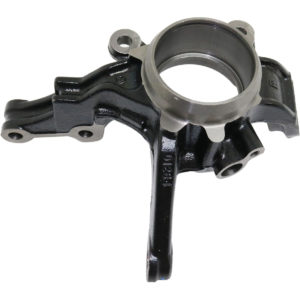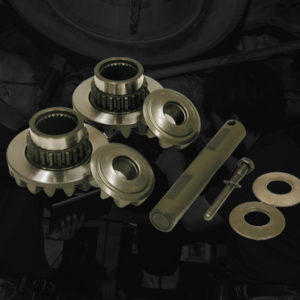Many parts come into play when it comes to your vehicle’s handling. Aside from having an effective suspension setup, a fully functional steering system is also key to maneuvering your daily driver with ease.
One of the several components in the steering system that helps your vehicle respond to certain motions is the steering stabilizer.
What Does a Steering Stabilizer Do?
A steering stabilizer, also known as a steering dampener, functions the same way as a shock absorber.
The steering stabilizer dampens and absorbs sudden motions in the steering linkage to improve vehicle handling and reduce the shimmy in the steering wheel.
Essentially, the stabilizer prevents steering wheel kickback whenever the front tires go over bumps or holes on the road.

Steering stabilizers are usually found in trucks, vans, and SUVs. This is because they have larger tires than passenger cars, making them more susceptible to steering wandering.
A steering stabilizer is also common in vehicles with a high positive caster setting. These are the vehicles that have their top upright mounting points leaning rearward.
Aside from improving a vehicle’s handling, steering stabilizers also absorb some of the impact that goes to the suspension system when driving over bumps or making fast turns.
As a result, parts like the suspension bushings and ball joints last longer than their intended service life.
What Are the Symptoms of a Bad Steering Stabilizer?
The steering stabilizer relies on hydraulic fluid to absorb sudden motions. Over time, debris, the elements, and corrosion can damage the stabilizer and create a leak. In some cases, steering stabilizers can simply wear out like shocks.
Once this happens, you might notice a jerking or jostling motion from the steering wheel when you go over bumps or potholes.
There might also be instances where the steering wheel is difficult to maneuver and wanders more often than normal.
A damaged stabilizer can even result in uneven tire wear.
How Do You Diagnose a Worn-Out Steering Stabilizer?
Turn the steering wheel while the engine is off and the vehicle’s front end is lifted.
You should feel resistance when turning left and right. If there’s only little resistance, check for fluid leaks, worn-out bushings, or lack of tension.
What Are the Types of Steering Stabilizers?
There are generally two types of steering stabilizers: single and dual.
Single Steering Stabilizer
A single steering stabilizer is usually found on vehicles that don’t have heavy-duty functions. It’s ideal for tires that are 33 inches or smaller.

Dual Steering Stabilizer
A dual steering stabilizer is designed for vehicles with 35-inch tires or bigger. It’s also ideal for trucks or SUVs that tow heavy equipment like winches and snow plows.
Is a Dual Steering Stabilizer the Better Option?
Not necessarily. The best type of steering stabilizer largely depends on your driving habits and your vehicle setup. The size and weight of your vehicle will also determine the appropriate steering stabilizer for it.
If you frequently go on trail riding activities and have a suspension lift or level kit, then a dual steering stabilizer might be the way to go.
A dual steering stabilizer is intended for vehicles with a two-inch level or two-inch high front bump stop spacer.
Installing this type on a vehicle at stock height can cause the stabilizer to hit the frame and eventually get damaged along with the mounting brackets.
How Much Will a Steering Stabilizer Replacement Cost?
A new steering stabilizer can cost about $132. You can expect to pay another $100 to $175 to have a trained professional install it for you.
Can I Replace the Steering Stabilizer by Myself?
Steering stabilizer replacement is generally considered a DIY-friendly task. It only involves raising and securing the vehicle and unbolting the old stabilizer before installing the new one.
But before mounting the replacement stabilizer, be sure to clean any dirt and grime surrounding the area as well. The new steering stabilizer should also have its plunger compressed halfway.
Doing so will give the stabilizer enough room to adjust in either direction.
You can also consider taking a trip to the nearest auto repair shop to have a trained professional install your new steering stabilizer. This will ensure that all steps for installation are followed correctly.
Other Steering Components to Consider Replacing

The steering stabilizer isn’t the only component that could wear out or get damaged after some time. If you’re driving a lifted vehicle or one that has oversized tires, you can expect other steering components to wear out faster than normal.
If you’re driving a lifted vehicle or one that has oversized tires, you can expect other steering components to wear out faster than normal.
–Anthony Harlin, ASE Certified Master Automobile Technician
Below are other common wear items that you should look out for in a conventional steering gear and parallelogram linkage.
Idler Arm
It might take anywhere between 40,000 to 60,000 miles before the idler arm begins to show signs of trouble.
The idler arm can be found on the opposite side of the pitman arm. It stabilizes the center link, preventing it from moving and flexing as the vehicle goes over bumps.
The idler arm helps produce a swivel movement and resists an up-down movement. In some cases, the idler arm comes in two pieces, which you’ll have to buy separately.
Inner and Outer Tie Rod Ends
Tie rod ends connect the steering linkage to the steering knuckles and other linkage parts. Many tie rod ends use a steel ball stud that’s assembled into a hardened steel and thermoplastic bearing.
Normal wear and tear might require you to replace these tie rod ends. Experts note that outer tie rod ends might begin to fail anywhere between 60,000 to 100,000 miles.
Meanwhile, inner tie rod ends have an estimated mileage of 80,000 to 120,000 miles before they begin to wear out.
Center Link
A center link sits between the two tie rods and has an estimated mileage of 90,000 to 130,000 miles. It converts the gear arm’s swinging motion to a linear or back-and-forth motion.
Pitman Arm
The pitman arm moves whenever the steering wheel does. The pitman arm is splined to the steering gear through the center link and tie rods. This part can begin to wear out anywhere between 100,000 and 150,000 miles.
Any information provided on this Website is for informational purposes only and is not intended to replace consultation with a professional mechanic. The accuracy and timeliness of the information may change from the time of publication.






























